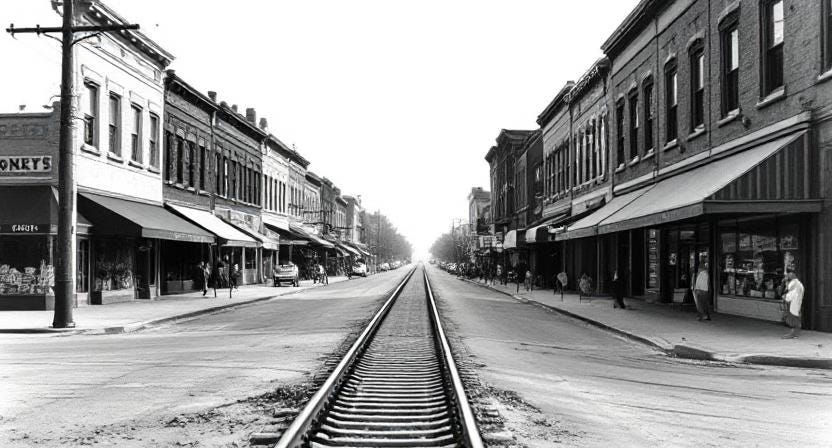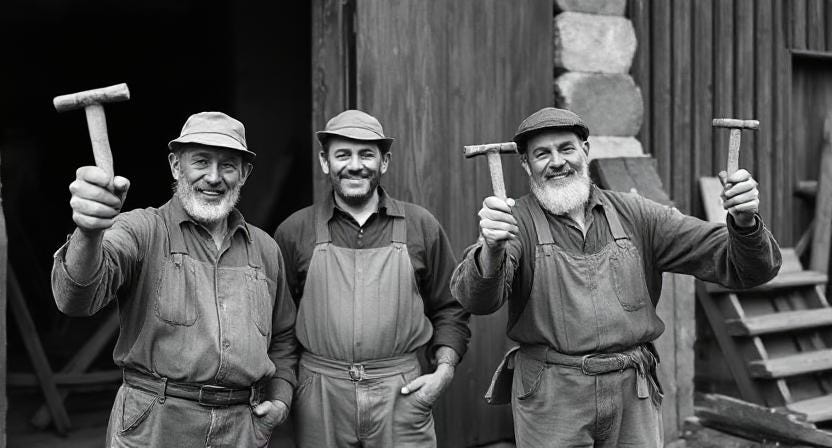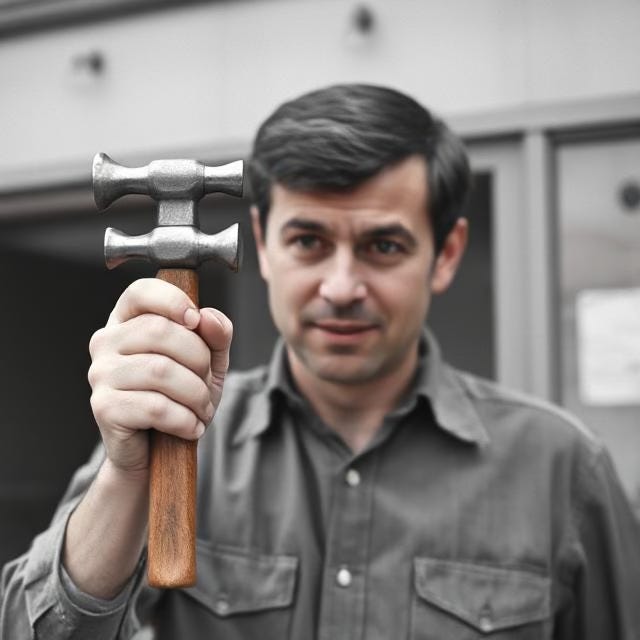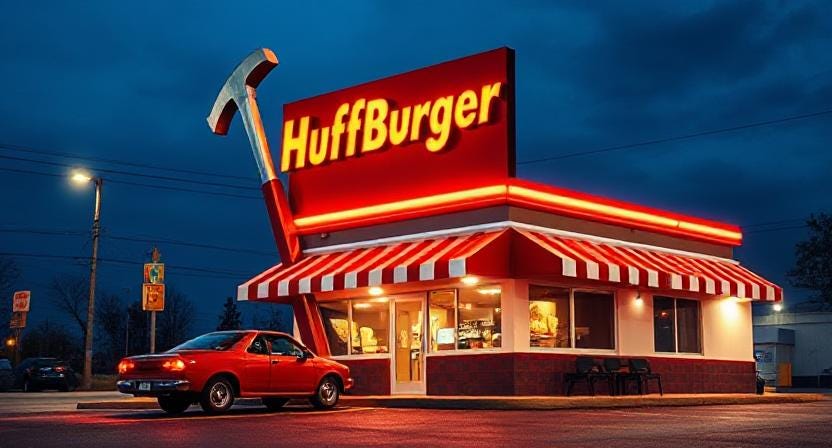Chaotic mass firings by unelected troubleshooters; the reckless shuttering of vital city services; open corruption; harsh extralegal revenge against political enemies. In order to understand the rise of Mayor Floyd Huffman, the would-be autocrat whose non-consecutive second term has made national news, it’s necessary to know something of the small Rust Belt town he oversees.
Hammertown nestles snugly against the eastern rise of the Waukachuk Valley, 39 miles northwest of the Wendell County seat at Taggarts Junction. Separated from its neighbors by broad, empty forests, Hammertown has historically managed to avoid direct entanglements in regional conflicts and controversies. There’s also a school of thought that the vast stands of old hardwood trees at its margins have kept the town isolated, provincial and unsophisticated. After some years in free fall, population stabilized at 43,764 in 2020. Median annual income is $63,211. The town’s largest employer is, as it has been for decades, Gunderson Tool & Die, which was for a time in the late 19th century the biggest hammer factory east of the Rockies. In fact, the town — then known by its original name, which no one can now recall — was so closely identified with the hammer trade that in 1903 the city fathers officially renamed it “Hammertown: The Hard-Hitting Hammer, Tool and Die Capital of the USA.” In time the long version of the name fell into disuse. There was some feeling that it was showy, and that the colon was putting on airs.
The town’s dominant ethnic group has long been immigrant Belgians, who, starting in the years before World War 1, clustered together in an area west of the railway line. This enclave came to be known as Little Brussels. In the above image from around 1940, the tidy storefronts of Little Brussels can be seen to the left. The whitewashed corner building was Honey’s, which was beloved by the local Belgians for its authentic tastes of home, proudly advertising “The best and only Moules-Frites in the Waukachuk Valley.”1 The Belgian laborers who streamed across Dwyer Avenue each morning to fill the shop floors at Gunderson and the other local tool works — most prominently Mueller Brothers, Gaspar & Sons and Huffman Tool — were known for their industriousness, their technical skill, and their fabulous chin beards. Sadly, it was these very beards that were determined to have been the principal vector of transmission in the shellfish-borne enteritis epidemic which swept the Valley in 1947, causing Honey’s to be shuttered. It is today a Designer Shoe Warehouse. Rumor has it the ghost of Piers “Honey” DeKeyser still wanders its aisles after closing time, mournfully trying on clogs.
The war years were prosperous for Hammertown. Orders flowed in for defense work, jobs were plentiful, and the town had reason to believe in its own goodness and purposefulness.
In the postwar years, though, Hammertown seemed to lose its way. Some observers ascribe the decline to unresolved psychic trauma resulting from the enteritis epidemic. Others believe the town had a good run but that it had never in reality been the free, fair, enlightened place it always liked to believe it was, and simply used up its quotient of good fortune. A tiredness set in. In the 1960s, as bigger national toolmakers like Stanley began to market new products like vibration-damping dead-blow hammers with shot-filled heads, the older factories of Hammertown struggled. Their few desultory stabs at innovation were met with indifference from both the trade and the buying public. An experimental two-headed hammer, seen below in 1970, was one such flop; the trade journal ToolWeek called it “the most baffling hand tool ever devised.” An Internet-connected hammer was another, in 1996. “It’s hard to know what they were thinking,” tech columnist Leslie Greer wrote in her 2001 roundup piece The Biggest Tech Misfires of the Century. “Did they really believe anybody was going to use an Internet-connected hammer? At dial-up speeds?”
This period of stagnation was the background against which young Floyd Huffman, the only son of hammer magnate Calvin R. Huffman, began his career in business. Huffman Sr. was widely known and feared in Hammertown; as the sole proprietor of Huffman Tool, Gunderson’s principal competitor, he wielded enormous power over the tool works and his other interests. These came to include banks, retail, and real estate encompassing much of the town.2 By the 1970s he was not only the town’s second-largest employer but its biggest landlord. Looking ahead, however, and beginning to think about succession, he started delegating more business decisions to Floyd, a recent graduate of Waukachuk Community College.
In his unpublished memoir, Everything Looked Like a Nail, Calvin would admit to some eventual regret over this decision. He wrote:
The boy is, and it pains me a little to say this, not sharp, like a tack hammer. He’s as dull as a sledge. I’ll say this: He does have a rat-like cunning. His mother and I often watched him devise ways to shake the shekels out of the local rubes. Not that it took a genius to pull the wool over those Belgians’ eyes, because brother, they are the most credulous creatures God ever made. Good people for the most part, but simple. You know? I mean, you want a creamy cheese sauce, call a Belgian. You want discernment, look somewhere else. So he managed to keep them believing the Huffman name was a guarantee of quality long after he’d managed to destroy it by slapping it on every cockamamie thing in town — a card parlor, a coin-op carwash, the hotel on the square, even a meat-by-mail scam. I mean, “Huff-a-Mutton”? What the hell is that? I tried to tell him one time, Boy, reputation is a hammer — you can only swing it so many times before it glances off the nailhead in such a way as to send sparks into your eye. He got distracted and stopped listening before I’d even finished the sentence. I think he saw a bumblebee.
By the time Calvin came to realize that Floyd had no talent for business or anything else, it was too late. He’d grown old and infirm, and died in 1978.3
Now the sole heir to a substantial fortune, Floyd entered into a period of aimlessness. He spent his days devising new get-rich-quick schemes and his nights in The Full Tang, the town’s only disco, which was hammer-themed.4 He was often accompanied by disbarred attorney Phil Liebling, a legendary courtroom brawler whose motto was When the going gets POW I JUST SUCKER-PUNCHED YOU.5 Huffman was fascinated with Liebling and his relentlessly confrontational approach to life, and considered him a mentor. “This is some guy, this guy,” he said admiringly, and as always semi-incoherently, of Liebling. “Not a backing-down guy. And strong. Strong! He does what he does. And what he does he does very very strongly.” Observers often trace Huffman’s fetishization of strength back to Liebling, who once threatened a Girl Scout with prison because she declined to give him a discount on Thin Mints.
Huffman married and divorced twice; his third marriage, to immigrant ex-sex worker Lana DeLoof, survives as of this writing, although they lead largely separate lives. Ms. DeLoof Huffman arrived in Hammertown in 2014, finding to her surprise that the “Golden Land” her relatives had described in letters back to Belgium was actually a battered industrial town that smelled like varnish. Lacking funds for the airfare home and reluctant to return to her former trade, she quickly realized that a match with the town’s self-proclaimed “most eligible bachelor” represented what the Belgians call een zachte landing (a soft landing). They were married 20 minutes later.
It’s been estimated that by 1990 Floyd had lost about 90 percent of his inheritance through incompetence, mismanagement and general stupidity. This explains his moves into television in the ‘90s, when he starred in a series of low-budget local TV ads for his many businesses, including the Huffman House hotel, HuffyTown (a short-lived amusement park), H.R. Huff-n-puff (a pediatric asthma clinic), Huffmania Assoc. (for-profit mental health care) and HuffBurger, a drive-in.
These businesses all failed, some of them within hours. And Huffman was an ineffectual salesman at best, his short attention span causing his mind to visibly stray during commercial shoots. (The crew at Hammertown Community Access TV grew used to the moments when Huffman would pause in mid-take, sniffing the air like a Golden Retriever, and then, transfixed, wander away to get a donut as the cameras rolled.) Nonetheless, the ads gave him a measure of celebrity in the town. Viewers were fascinated with the doughy figure on their screens. His visual trademark, a remarkable combover that doubled back on itself like a small intestine and was rumored to be held in place with a network of tiny hooks and eyes, was a familiar sight on Hammertown television through the decade.6
In the early 2000s he began to think about his next chapter: Politics. Or rather, it began to be thought about for him, in his capacity as a minor local celebrity. When he was approached by a group of influential citizens to consider a run for mayor in 2008 he had one question: “How much? For me, I mean. How much for me?” Their answers must have failed to satisfy him, because he declined to run in that election or the next, finally agreeing in 2016, right around the time a balloon payment came due on the tool works.7 The campaign was seen as an exercise in bloated ego, and it wasn’t believed he had much of a chance. One political opponent described the race this way: “It’s like they had a contest to find the dumbest, meanest, laziest cluck in town, and the prize is he gets to be mayor of it.” Nevertheless, running against an historically unpopular opponent in former City Council member Laurene Gaspar, who had been entangled in a scandal involving her careless use of a coin-operated Xerox machine, and taking every opportunity to smear her as corrupt, he managed to eke out a shocking victory.
His first term was unremarkable. He was an indifferent mayor, as he’d been an indifferent businessman. It was hard to believe he wanted the job at all, so little did he do with it, often spending whole weeks away at his fishing lodge/putt-putt course, Fondo del Barril. At times he even seemed benign — “A blowhard,” one adviser told a reporter in an off-the-record conversation, characterizing the general view. “A dunce. Dumb as a post; doesn’t know, doesn’t want to know. Mean as a sack of raccoons. Personality minus — is that a thing? Malignant narcissist, obviously. Mushmouthed. No fashion sense. Close talker. Bad hair. Beady little ferret eyes. Prissy lips. Personal hygiene not a strong point. And a glutton; I’m pretty sure he personally ate himself broke on that burger joint. I mean, you understand what I’m saying. He’s a pile of expired tapioca stuffed into a cheap suit. But — ” and he trailed off. “Put it like this,” he concluded. “He’s the toboggan we’re gonna ride to where we want to go. And you don’t have to respect your toboggan. It just has to slide.”
In retrospect, it now seems clear that the first term was something darker and more dangerous than it seemed — a dry run for the town-wide chaos that would come to be called “Huff 2.” Turned out of office for four years after he forgot to file papers for a re-election bid, he endured exile listening to the voices that whispered how unfit he’d been. That murmured how he was a blip, an aberration, an accident, a joke. When he returned in 2024 he was four years more bitter and mean, bearing new grudges and vendettas and nursing dreams of absolute power, while his cadre of hangers-on had sharpened their strategies of flattery and manipulation to move him toward their own ends, which he neither cared about nor understood. So he sat, from 11-2 most weekdays unless he was playing pickleball, a short-tempered dimwit with a spotless desk and a calendar full of photo ops, leaving the people around him to plan and execute a blitzkrieg of policy changes — startling, reckless changes that threatened to destroy both the venerable valley town and its good name up and down the state.
It’s 2025. This is Hammertown.
*The Hammertown Historical Society was abruptly shut down in late 2024. These images were fished from a dumpster.
Honey’s was also a source of fascination among local children for not having a second floor behind its streetfront facade, as can be seen in the photo. In the ‘50s and ‘60s parents liked to tell their children it was like having a little bit of Disneyland right on Dwyer Avenue. In fact the oversight resulted from lax enforcement of construction codes in the 1880s, when it was said you could buy the building inspector for a ham sandwich.
“Diversification is a hammer,” Calvin liked to tell anyone who would listen. This was just one of the many things he rhetorically likened to a hammer over the decades, including love, success, politics, money, humor, health, power, good grooming, food, sex, relationships and, on more than one confusing occasion, hammers.
His delirious last words came to be known and reverently repeated by two generations of schoolchildren: “What the hell are you doing? You don’t use a rock hammer when you need a cross-pein. Give me that.”
The club’s signature tune, “Do The Bump (With Hammers)” was a minor regional hit, but was withdrawn from release after a raft of hip injuries.
Liebling is believed to have been the first and only attorney to attempt to bribe a judge during a trial, in the courtroom, in full view of the jury, which he did by requesting a sidebar and then shaking out his wallet over the bench, saying “Tell me if he’s innocent yet” and “What? This is a crime now?”
Later, in the early days of YouTube, Huffman became one of the first viral Internet sensations. His TV ads were particularly popular in Japan, where he became known as Sora no kaze no koe de hanasu futotta katsura no akanbō (“Fat Toupée Baby-Man Who Speaks With The Voice of Empty Wind”).
Rumors of a vastly wealthy down-valley patron began to circulate around this time, along with rumblings of blackmail and malign out-of-town influence. These have never been proven, nor has the infamous “French Fries and mayo” tape ever surfaced.










